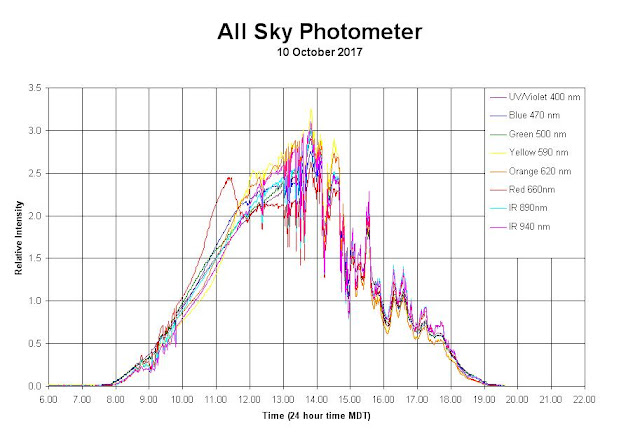Rachel like the Oregon Coast; in fact, it's one of her favorite places on Earth. So while we visited Yachats last weekend, I took the opportunity to do some science. It as foggy and cloudy during our visit, so I'm going to need to return for a comparison during sunny conditions.
Near Infrared and Thermal Infrared Imaging
First, I took images of the ocean and coast using my near infrared (NIR) and thermal infrared (long-wave infrared (LWIR) cameras. In NIR, smooth water appears black because surface of water does not reflect solar NIR. It appears rough water is different. The images below show the water caps reflecting plenty of NIR. During a clear day, the sky is black in NIR since molecules in the atmosphere don't refract the sun's NIR. Foggy days appear much differently.
 |
| Looking North from the beach park in Yachats, OR |
 |
| Looking south from the same city park |
 |
| Looking west. |
LWIR makes a temperature map, so yellow and white are hottest and blue and black are the coldest. The rocks making up the beach are warmer than the ocean, as the image below shows.
 |
| Rocks are yellow, and therefore warmer than sea water. |
 |
| Looking into the ocean during a foggy day. The striations seen in the yellow are likely waves rolling into shore. |
Muon Detection
Muons are subatomic particles and relatives of electrons (in fact, muons or mu mesons decay into electrons and have a half-life of 2.2 microseconds). Muons are created in cosmic ray collisions and reach the ground only because of time dilation due to their relativistic speeds. When muons strike materials called scintillators, they create tiny sparks of light. Photomultipliers, either tube or solid-state, amplify that tiny spark to a measurable voltage spike. The experiment I took to Yachats consists of two scintillaotr paddles and an Audrino to measure the voltage spikes created by muons passing through both scintillators. The graph below shows the incidence of muons over a nearly 12 hour long detector run.
Drone Flight
I also flew a drone over the beach and ocean to see what the ocean waves look like from up to 400 feet above the surface. Looking at waves from the beach gives no indication just how far out the waves extend.
 |
| About 200 feet above the waves looking out to the ocean. |
 |
| About 400 feet up and entering the base of the clouds. |
 |
| About 100 feet out over the ocean and looking towards short from high altitude. I was worried about my drone losing power and splashing down. |
Next Time
It was too foggy and cloudy to get the data I was hoping for. so perhaps some time next year I'll head back out and get the same data during a sunny day. This would also let me gather photometer data from sea level.











































